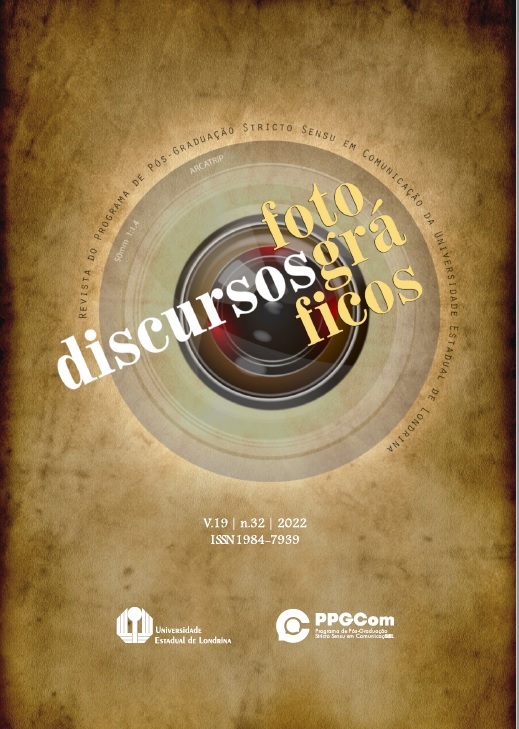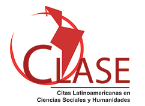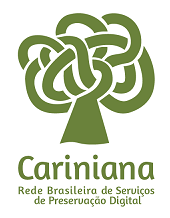Virtual Reality, New Ways of Storytelling: Approaches to 360° Immersive Film Narrative
DOI:
https://doi.org/10.5433/1984-7939.2022v19n32p183Keywords:
Virtual reality, Audiovisual narrative, Immersive cinema, 360° cinemaAbstract
The number of 360° virtual reality (VR) films has increased in recent years. These are mainly screened in film festivals, and web platforms. However, the narrative rules of immersive cinema currently remain unclear. Given this, our aim is to understand how a 360° VR film is narrated, finding which elements still prevail in non-immersive cinema, and which new elements are being introduced with it. A qualitative methodology was used, based on a literature review, the analysis of three short VR films, and six semi-structured interviews with immersive film creators. The paper concludes with narrative suggestions in relation to the importance of the user/character, the atmospheres, and the direction of the gaze for the creation of 360° VR stories.
Downloads
References
AYLETT, Ruth; LOUCHART, Sandy. Towards a narrative theory of virtual reality. Virtual Reality, Nueva York, EE. UU., v. 7, n. 1, p. 2-9, 2003. DOI:10.1007/s10055-003-0114-9 DOI: https://doi.org/10.1007/s10055-003-0114-9
BAILBLÉ, Claude (2015). El dispositivo cine 3D. DeSignis, Rosario, Argentina, v. 23, 2015, p. 17-27.
BARBERÁ, Víctor. Vídeos 360º narrativos: propuesta de un modelo de análisis. Paradigmas de la narrativa audiovisual. ASRI. Arte y Sociedad. Revista de Investigación en Artes y Humanidad digitales, [S. l.], n. 18, p. 164-177, 2020. Disponible en: https://revistaasri.com/article/view/4761. Acceso en: 30 mar. 2022.
BEING John Malkovich. Dirección: Spike Jonze. EE.UU: Astralwerks, 1999.
BELTON, John. Widescreen Cinema. Cambridge, EE. UU.: Harvard University Press, 1992. DOI: https://doi.org/10.4159/harvard.9780674335349
BENÍTEZ DE GRACIA, María José; HERRERA DAMAS, Susana. El reportaje inmersivo en vídeo en 360º en los medios periodísticos españoles. Revista de Comunicación, Piura, Perú, v. 17, n. 2, p. 66-100, 2018. DOI: 10.26441/RC17.2-2018-A3 DOI: https://doi.org/10.26441/RC17.2-2018-A3
BONILLA, Diego; GALÁN, Helena. El cine sin encuadre: propuesta de escala de implicación narrativa en realidad virtual. Anuario electrónico de estudios en comunicación social "Disertaciones", Rosario, Argentina, v. 13, n. 2, p. 1-16, 2020. DOI: 10.12804/revistas.urosario.edu.co/disertaciones/a.8252 DOI: https://doi.org/10.12804/revistas.urosario.edu.co/disertaciones/a.8252
BRILLHART, Jessica. The Language of VR: In the Blink of a Mind. Medium. [S. l.], 12 ene. 2016. Disponible en: https://medium.com/the-language-of-vr/tagged/editing. Acceso en: 30 ene. 2021.
CÁRDENAS QUIROGA, Elsa Adriana; MORALES MARTÍN, Luz Yolanda; USSA CAYCEDO, Andrés. La estereoscopía, métodos y aplicaciones en diferentes áreas del conocimiento. Revista Científica General José María Córdova, Bogotá, Colombia, v. 13, n. 16, p. 201-219, 2015. DOI: 10.21830/19006586.37. DOI: https://doi.org/10.21830/19006586.37
CHATMAN, Seymour. Historia y discurso. La estructura narrativa en la novela y en el cine. España: Taurus Humanidades, 1990.
CHENG, Kevin; CAIRNS, Paul. Behaviour, Realism and Immersion in Games, ACM Conference on Human Factors in Computing Systems, CHI05, 2005, Portland, p. 1272-1275. DOI: https://doi.org/10.1145/1056808.1056894
CONSTITUCIÓN. Dirección: Leonardo Medel. Película. Chile: Constitución Media, Merced, 2016.
CORTÉS-SELVA, Laura. En busca del VRCinema. Del cine proto-inmersivo al cine inmersivo. Discursos fotográficos, Londrina, PR, v. 12, n. 20, p. 173-204, 2016. DOI: 10.5433/1984-7939.2016v12n20p173 DOI: https://doi.org/10.5433/1984-7939.2016v12n20p173
CUADRADO, Alfonso. Tocar a través del cuadro: una genealogía del interfaz como metáfora de control en el espacio del arte, el cine y los videojuegos. Icono 14, Madrid, España, v. 12, n. 3, p. 141-167, 2014. DOI: 10.7195/ri14.v12i2.708 DOI: https://doi.org/10.7195/ri14.v12i2.708
DAMIANI, Jesse. The great semantic divide: Virtual Reality vs. 360-degree video. Uploadvr, [S. l.], 26 ago. 2016. Disponible en: https://uploadvr.com/virtual-reality-vs-360-degree-video-semantic-divide. Acceso en: 20 feb. 2021.
DE LA PEÑA, Nonny et al. Inmersive journalism: Inmersive virtual reality for the First-Person Experience of News. Presence, Cambridge, EE. UU., v. 19, n. 4, p. 291-301, 2010. DOI: 10.1162/PRES_a_00005 DOI: https://doi.org/10.1162/PRES_a_00005
DOOLEY, Kath. Storytelling with virtual reality in 360-degrees: a new screen grammar. Studies in Australasian Cinema, [S.l.], v. 11, n. 3, p. 161-171, 2017. DOI: 10.1080/17503175.2017.1387357 DOI: https://doi.org/10.1080/17503175.2017.1387357
ECHEVERRÍA, Javier. Virtualidad y grados de libertad. Daimon Revista internacional de filosofía, Murcia, España, n. 24, p. 23-30, 2001.
EL LLANTO del bebé. Dirección: Jorge Esteban Blein. Argentina, 2017. Película. 1 video (8:19 min). Disponible en: https://www.youtube.com/watch?v=YdCjxlmfVfc. Acceso en: 20 feb. 2021.
FIELD, Syd. El libro del guion. Madrid, España: Plot, 1995.
GAUDENZI, Sandra. Interactive Documentary: towards and aesthetic of the multiple. Londres, Reino Unido: University of London, Centre for Cultural Studies (CCS) of Goldsmiths, 2009.
GAUDREAULT, André; JOST, François. El relato cinematográfico. Barcelona, España: Paidós Ibérica, 1995.
GÖDDE, Michael et al. Cinematic Narration in VR-Rethinking film conventions for 360 degrees. En: CHEN, Jessie; FRAGOMENI, Gino (eds.). Virtual, augmented and mixed reality applications in health, cultural heritage, and industry. Nevada, EE. UU.: Springer, 2018. p. 184-201. DOI: 10.1007/978-3-319-91584-5_15. DOI: https://doi.org/10.1007/978-3-319-91584-5_15
HERNÁNDEZ, Roberto; FERNÁNDEZ, Carlos; BAPTISTA, Pilar. Metodología de la investigación. 6. ed. Ciudad de México: Mc Graw Hill, 2014.
IVARS, Begoña; MARTÍNEZ, Francisco-Julián. En busca de narrativa inmersiva con la tecnología de vídeos 360º. Sphera Pública, Murcia, España, v.1, n. 20, p. 160-177, 2020.
JURADO-MARTÍN, Montserrat. Aproximación a los certámenes cinematográficos de realidad virtual, aumentada e inmersiva en América Latina. Comunicación y medios, Santiago de Chile, v. 29, n. 42, p. 134-145, 2020. DOI: 10.5354/0719-1529.2020.56993 DOI: https://doi.org/10.5354/0719-1529.2020.56993
MARTÍNEZ, Francisco-Julián. Impresiones sobre Carne y Arena: práctica cinematográfica y realidad virtual. Miguel Hernández Communication Journal, Elche, España, n. 9, p. 161-190, 2018. DOI: 10.21134/mhcj.v0i9.222. DOI: https://doi.org/10.21134/mhcj.v0i9.222
MARTÍNEZ, Francisco-Julián; IVARS, Begoña; MARTÍNEZ, Alba-María. Ubicuidad dual: base para la efectividad del VRcinema como herramienta prosocial. Análisis de Hunger in LA y After Solitary. Perspectivas de la comunicación, Temuco, Chile, v. 13, n. 1, p. 155-176, 2020. DOI: 10.4067/S0718-48672020000100155 DOI: https://doi.org/10.4067/S0718-48672020000100155
MARTÍNEZ, Francisco-Julián; ROSELLÓ, Emilio. La dirección y realización audiovisual de realidad virtual. Análisis de Queerskins: a Love Story, una aproximación al cine volumétrico. ASRI. Arte y Sociedad. Revista de Investigación en Artes y Humanidad digitales, [S. l.], n. 18, p. 111-125, 2020. Disponible en: https://www.eumed.net/rev/asri/18/realidad-virtual.pdf. Acceso en: 10 feb. 2021.
MCKEE, Robert. El guion. Sustancia, estructura, estilo y principios de la escritura de guiones. Barcelona, España: Alba Editorial, 2015.
MCLUHAN, Marshall. Comprender los medios de comunicación: las extensiones del ser humano. Barcelona, España: Paidós, 1996.
MCMAHAN, Alison. Immersion, Engagement and Presence. En: WOLF, Mark; PERRON, Bernard (eds.). The Video Game Theory Reader. Nueva York, EE. UU: Routledge, 2003. p. 77-78.
MONJE, Carlos Arturo. Metodología de la investigación cuantitativa y cualitativa. Neiva, Colombia: Universidad Surcolombiana, 2011.
MORA-FERNÁNDEZ, Jorge. Medios interactivos y cultura digital: Alfabetización hipermedia en Perú y Bolivia. Comunicar, Huelva, España, v. 20, n. 39, p. 139-149, 2012. DOI:10.3916/C39-2012-03-04 DOI: https://doi.org/10.3916/C39-2012-03-04
NOTES on Blindness. Dirección: Arnaud Colinart, Amaury La Burthe, Peter Middleton y James Spinney. Película. Francia: Audiogaming, 2016.
NOTES to My Father. Dirección: Jayisha Patel. Película. EE. UU.; Reino Unido: Oculus VR, Reel FX Creative Studios, 2017. 1 video (11:22 min). Disponible en: https://www.youtube.com/watch?v=En38_u_ev5k. Acceso en: 10 feb. 2021.
OCULUS. Oculus Rift S ya no está disponible. [S.f.]. Disponible en: https://www.oculus.com/rift-s/?locale=es_ES. Acceso en: 10 feb. 2021.
ORTEGA-RODRÍGUEZ, Pablo Javier. From extended reality to the metaverse: a critical reflection on contributions to education. Teoría de la Educación. Revista Interuniversitaria, España, v. 34, n. 2, p. 189-208, 2022. DOI: 10.14201/teri.27864 DOI: https://doi.org/10.14201/teri.27864
PARENT-ALTIER, Dominique. Sobre el guion. Buenos Aires, Argentina: La Marca Editora, 2005.
RABINOWITZ, Lauren. From Hale's Tours to Star Wars: Virtual Voyages and the Delirium of the Hyper-Real. Iris, [S. l.], v. 25, 1998.
ROSE, Frank. The Art of Immersion. How the digital generation is remaking Hollywood, Madison Avenue and the way we tell stories. Nueva York, EE. UU.: W. W. Norton & Company, 2011.
RUBIO-TAMAYO, José Luis; GÉRTRUDIX-BARRIO, Manuel. Realidad virtual (HMD) e interacción desde la perspectiva de la construcción narrativa y la comunicación: propuesta taxonómica. Icono 14, Madrid, España, v. 14, n. 2, p. 1-24, 2016. DOI: 10.7195/ri14.v14i2.965 DOI: https://doi.org/10.7195/ri14.v14i2.965
RYAN, Marie-Laure. La narración como realidad. Barcelona, España: Paidós, 2004.
SEGER, Linda. Cómo convertir un buen guion en un guion excelente. Madrid, España: RIALP, 1987.
SORA, Carles. Una inmersión en el audiovisual VR y 360. Serie DigiDoc-EPI, Barcelona, España, n. 1, 2017.
THE REMEDY. Dirección: Daniel Peixe. Película. EE. UU.: Oculus Quest, 2019.
TRICART, Celine. Virtual reality filmmaking. Techniques & best practices for VR filmmakers. Nueva York, EE. UU.: Routledge, 2018. DOI: https://doi.org/10.4324/9781315280417
TRUBY, John. Anatomía del guion. Barcelona, España: Alba Editorial, 2014.
TURKLE, Sherry. La vida en la pantalla. Barcelona, España: Paidós, 1997.
VILAS BOAS GONÇALVES, Yuri Antonio. Overview of Virtual Reality Technologies. En: Interactive Multimedia Conference, v. 2013, 2013, [S. l.].
VOICES of VR Podcast #292: The Four Different Types of Stories in VR. Locución de: Devon Dolan y Kent Bye. Podcast. 4 feb. 2016. Disponible en: https://voicesofvr.com/292-the-four-different-types-of-stories-in-vr/. Acceso en: 30 mar. 2022.
VOLVER a casa. Dirección: Catalina Alarcón. Película. Chile: Mimbre Producciones, 2017.
ZELCER, Mariano. Pantalla, imágenes y cámara en la realidad virtual: una aproximación. Imagofagia. Revista de la Asociación Argentina de Estudios de Cine y Audiovisual, n. 18, p. 322-343, 2021. Disponible en: http://www.asaeca.org/imagofagia/index.php/imagofagia/article/view/181. Acceso en: 30 nov. 2022. Acceso en: 10 feb. 2021.
ZILLES BORBA, Eduardo. Audiovisuales ampliados en la realidad virtual: inmersión, multisensorial y escenarios 360º. Sphera Pública, Murcia, España v.1, n. 20, p. 78-94, 2020.
Downloads
Published
How to Cite
Issue
Section
License
Copyright (c) 2023 Discursos Fotograficos

This work is licensed under a Creative Commons Attribution-NonCommercial 4.0 International License.
Discursos fotográficos adota a licença CC-BY-NC, esta licença permite copiar e redistribuir o material em qualquer meio ou formato, remixar, transformar e desenvolver o material, desde que não seja para fins comerciais. E deve-se atribuir o devido crédito ao criador.

Este obra está licenciado com uma Licença Creative Commons Atribuição-NãoComercial 4.0 Internacional.




















